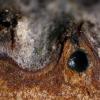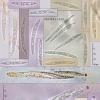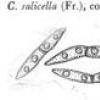
09-12-2025 12:06
 Andgelo Mombert
Andgelo Mombert
Bonjour,Je recherche l'article concernant Hypobryo

12-12-2025 18:39
Mirek GrycHello everyone.Macrofeatures similar to Mollisia b

07-12-2025 16:07
Arnold BüschlenHallo, ich habe in einer Moos-Aufsammlung (epiphy

08-12-2025 21:04
Mark Stevens"Hello everyone,I'm relatively new to microscopy (

08-12-2025 18:59
 Lothar Krieglsteiner
Lothar Krieglsteiner
.. found by a seminar-participant, I do not know t

08-12-2025 17:37
 Lothar Krieglsteiner
Lothar Krieglsteiner
20.6.25, on branch of Abies infected and thickened
Cryptodiaporthe?
Enrique Rubio,
29-03-2013 13:22
This fungus makes isolated, imersed, blackish perithecia up to 0.4 mm in diameter with very inconspicuous ostioles on small branches of an indeterminate deciduous tree (maybe Salix).
I think in a Cryptodiaporthe species and my guest is C. salicella, but my ascospores and asci are greater than the Wehmeyer's description. On the other hand this species seems to be very variably described in the literature.
What do you think?
Thanks again
Enrique
Hans-Otto Baral,
29-03-2013 16:19

Re : Cryptodiaporthe?
What is the staining reagent here, Congo Red and Cresyl blue?
Zotto
Zotto
Alain GARDIENNET,
29-03-2013 16:31
Re : Cryptodiaporthe?
Salut l'ami Enrique,
Very interesting.
Probably a Plagiostoma species. (You know perhaps that several species like salicellum have been placed in Plagiostoma genus, Meijia & al.2011).
There are some species on Salix, most of them in North America. But even if your record is closed to Plagiostoma salicella, the ascospores are too much long to recognize it here.
How is the neck ? Is there a white area around ostiole ?
Alain
Very interesting.
Probably a Plagiostoma species. (You know perhaps that several species like salicellum have been placed in Plagiostoma genus, Meijia & al.2011).
There are some species on Salix, most of them in North America. But even if your record is closed to Plagiostoma salicella, the ascospores are too much long to recognize it here.
How is the neck ? Is there a white area around ostiole ?
Alain
Alain GARDIENNET,
29-03-2013 16:33
Re : Cryptodiaporthe?
You cited Wehmeyer. In its workshop, the closest species to yours is Diaporthe megalospora , but it's on Sambucus and really different too.
Alain GARDIENNET,
29-03-2013 16:35
Re : Cryptodiaporthe?
And how many perithecia for one stroma ?
Alain GARDIENNET,
29-03-2013 16:37
Re : Cryptodiaporthe?
I think that you should contact Donald Walker, working actually on Plagiostoma genus :
walkerd@findlay.edu
China, America have new species on Salix. Why not Europe ?
Best regards,
Alain
walkerd@findlay.edu
China, America have new species on Salix. Why not Europe ?
Best regards,
Alain
Alain GARDIENNET,
29-03-2013 16:52
Re : Cryptodiaporthe?
You will find the doc (the more actual on this genus for the moment), in an old post in this forum :
http://www.ascofrance.fr/search_forum/14961
Alain
http://www.ascofrance.fr/search_forum/14961
Alain
Enrique Rubio,
29-03-2013 17:14
Re : Cryptodiaporthe?
Thank you to all
Zotto, the staining reagent were congo red and nigrosine
The 1-peritheciate fruit bodys are very scattered on the branch. No strue stroma I have seen. No ventral black line. No white line around the very inconspicuous ostiole. I cannot see well the neck.
Thanks!
Zotto, the staining reagent were congo red and nigrosine
The 1-peritheciate fruit bodys are very scattered on the branch. No strue stroma I have seen. No ventral black line. No white line around the very inconspicuous ostiole. I cannot see well the neck.
Thanks!
Hans-Otto Baral,
29-03-2013 17:21

Re : Cryptodiaporthe?
Enrique:
nigrosin I though has a black colour. And it provokes a blue ring?
I assume that nigrosin works like a basic dye:
"Nigrosin WS is used in tests for viability: living cells exclude the dye, but it enters dead cells"
(wikipedia)
Zotto
nigrosin I though has a black colour. And it provokes a blue ring?
I assume that nigrosin works like a basic dye:
"Nigrosin WS is used in tests for viability: living cells exclude the dye, but it enters dead cells"
(wikipedia)
Zotto
Enrique Rubio,
29-03-2013 18:42
Re : Cryptodiaporthe?
Nigrosine has a blackish/bluish color under the microscope but perhaps the photoshop changes include more bluish hues to the apical apparatus.


